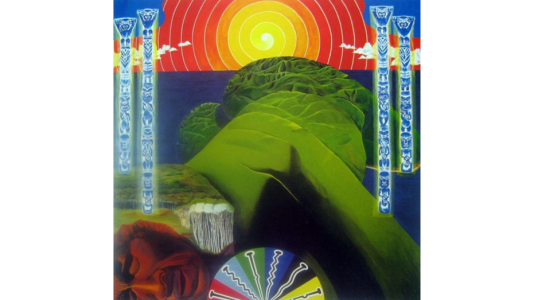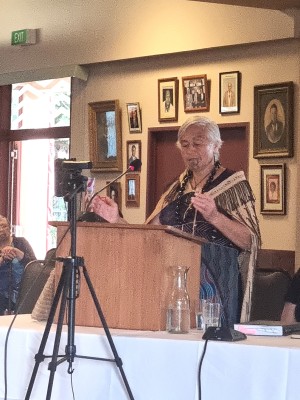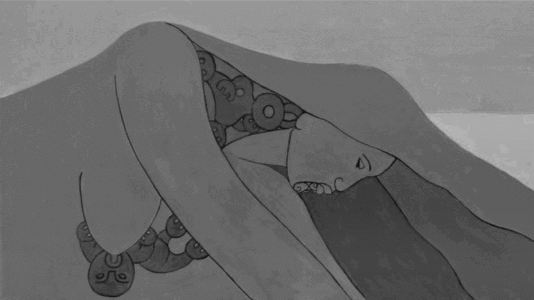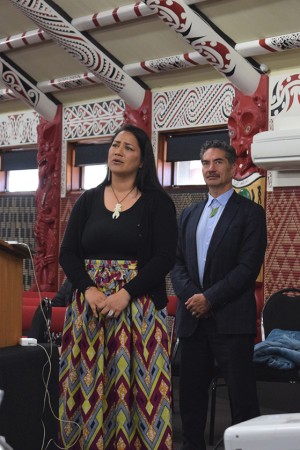Key evidence about atua whāea
See summaries of key briefs of evidence about atua whāea

Papatūānuku (1983) by Robyn Kahukiwa (pictured in document A30(c))
Professor Leonie Pihama (doc A19)(external link) argued that Pākehā ethnographers and writers have marginalised and misconfigured atua wāhine. Elsdon Best and Berys Heuer, she argued, interpreted atua wāhine through the lens of a patriarchal European culture; positioning them as ‘lesser’ than male atua and associated with ‘darkness and evil’. Professor Pihama said contradictions within these ethnographers’ work showed that traditional Māori societies did not consider atua wāhine (and wāhine more broadly) as lesser. She also emphasised the ‘range of iwi stories that speak to the origins or creation of humanity,’ rather than a single truth.
Te Ringahuia Hata (docs A30 and A30(b)) emphasised the centrality of atua wāhine in te ao Māori before colonisation. This relationship is embedded in the concept of whakapapa: ‘Whaka – means to create, to cause, to bring about or to action. Papa – comes directly from Papatūānuku. Therefore, whakapapa is about … womankind originating from our earth mother’. While Ms Hata said there are at least 80 atua wāhine; her evidence focused on Papatūānuku, Hineahuone, Hinetītama, and Whakaari. Ms Hata also acknowledged ‘the wisdom of the late Dame Mira Szaszy [the key claimant in Wai 381] in the struggle against patriarchy and the denial of the feminine divine’, quoting her evidence in the Muriwhenua Lands Hearings:
We are the children of Papatūānuku, the Earth Mother, one of our divine primal parents. We contend that all of nature derives from her – our lands, forests, rivers, lakes, and seas and all life contained therein. As such our spirituality is deep-rooted in the earth, the lands upon which our forebears lived and died, the seas across which they travelled and the stars which guided them to Aotearoa. They were also physically sustained by the produce of Tane and Tangaroa. The sanctity of the mauri of all things was respected.
Dr Aroha Yates-Smith (doc A47) spoke on the existence of atua whāea, referring to her published work on the subject and her doctoral thesis, Hine! E Hine! Rediscovering the Feminine in Maori Spirituality (1999), now widely regarded as a significant text on this topic.

Dr Aroha Yates Smith giving evidence at Tūrangawaewae Marae, Ngāruawāhia
Paula Ormsby (doc A55) opened her evidence by stating: ‘We are Daughters, Sisters, Mothers, Aunties and Grandmothers connected through[WK1] Whakapapa. We are Goddesses, we were formed from the sacred earth at Kurawaka and created with gifts of the gods. Her evidence detailed pūrākau and cosmology broadly; describing many atua, including Wainuiātea, Papatūānuku, Hineahuone, Hinetītama, Hine-Moana, Hine-te-iwaiwa, Mahora-nui-atea, Muriranga-whenua, Mahuika, and Tangotango.
Patricia Tauroa (doc A60) gave evidence about Papatūānuku, Hineahuone, Hinetītama, Hinenuitepō, Murirangawhenua, and Mahuika. In her view, these atua whāea are part of ‘our own DNA’ but knowledge about them was detrimentally impacted by the advent of missionary teachings.
Professor Rangi Mātāmua (doc A86) drew upon his understanding of Māori astronomy to explain that atua wāhine are embodied by various astronomical bodies. In particular, he named and described the atua associated with the seasons, the moon, and the stars (including Matariki and Puanga, whose appearance is associated with the New Year for many Māori).
Heeni Collins (doc A108) discussed the Io tradition from a Ngāti Raukawa perspective. This tradition considers Io-matua-kore (Io the parentless) the highest atua. Ms Collins referred to several early sources that record the importance of this tradition to Ngāti Raukawa, including notes from a hui held at Kihikihi in 1912 which discussed how ‘the concept of Io-matua was part of the cultural and religious heritage brought here on the Tainui waka’. She also referenced early Māori accounts of Io published in the Journal of the Polynesian Society in 1907. Ms Collins emphasised that all of the many names given to Io are gender neutral, reflecting the need for balance and unity between male and female elements, both spiritually and in Māori life.
Aroha Rickus (doc A140) discussed Papatūānuku, Hineahuone, Hineteiwaiwa, and Hinetītama. In her view, Māori cosmologies were characterised by a balance between atua wāhine and atua tāne, a gender balance which her tīpuna also strove to live out. However, she argued that ‘mana tāne has been protected and nurtured by our culture, whereas mana wāhine has been attacked and rendered invisible in contemporary Māori society’. One mechanism of attack, she argued, was the erasure of atua wāhine narratives by colonial and Christian discourses.
Hira Huata (doc A149) gave a detailed explanation of Māori cosmology, relaying that Io the Supreme Being had a union with Te Rikoriko, producing Te Ao (light) and Te Pō (darkness). Then came Ranginui and Papatūānuku, who begat all the celestial bodies. Ms Huata listed these celestial bodies, as well as the descendants of Tane and Hineahuone.

Papatūānuku me Rūāumoko (2019) by Robyn Kahukiwa (picture in document A30(c))
Dallas King (doc A150(a)) explained that wherever there are male atua, there are a female atua, some as opposing or balancing atua i.e. Ranginui and Papatuanuku; some as intermediary atua i.e. Tangaroa, Moana-tū-te-repo, and Tane Mahuta; and others as realms that had both male and female personifications, such as the ocean which is characterised as Tangaroa and Hinemoana.

Dallas King at Ngā Hau E Whā, Christchurch, pictured with lawyer Tavake Afeaki